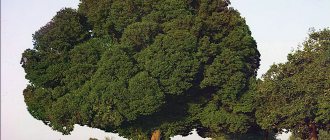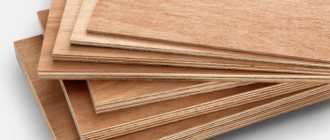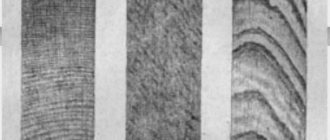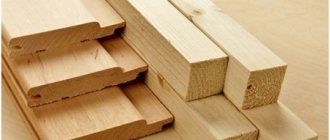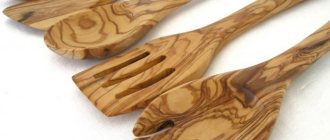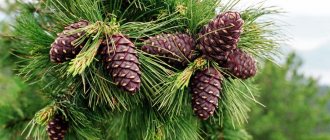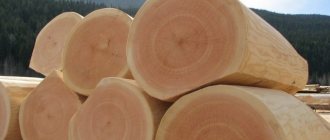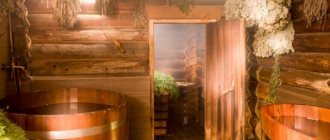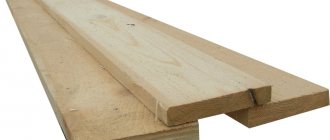Siberian cedar, belonging to the genus Pine, is a huge evergreen giant that can reach an age of 500-850 years. It is cultivated both for decorative purposes and for the extraction of seeds - nuts with high nutritional value. Cedar pine can grow in a wide variety of conditions. This opens up wide opportunities for cultivating it in your own garden plot.
Description of cedar pine
The evergreen tree is related in spirit to Korean cedar and other crops included in the informal group of cedar pines. It has become widespread in Western Siberia, the Urals, Kazakhstan, the Mongolian steppes, and China. Siberian pine pine can form pure forests - cedar trees or be combined with other coniferous representatives. It loves sandy and clayey soil, although it can also be found on rocky soil and in swamps. It is frost-resistant, but does not grow in areas with permafrost.
It tolerates shade well, but is demanding on certain growing conditions, such as heat, environmental humidity and soil. Its soft, durable and light wood with a characteristic odor is used in the production of furniture and stationery, and the nuts are widely used in cooking, medicine, and they also feed many animals in the taiga - chipmunks, sables, bears, and various birds.
What does cedar pine look like?
The girth of the trunk reaches 2 m. This is what a cedar pine is like, the height of which is 35-44 m. It has a dense multi-peaked crown with powerful branches. The trunk is erect and smooth, over time it becomes covered with scaly bark with cracks. The root system of the cedar pine has a short central core, from which powerful shoots branch off, running at a depth of 2-3 m. They are responsible for the stability of the tree.
The needles of this culture grow in bunches. Each has 5 needles. The white coating on cedar pine is its main feature. Due to the short growing season, the tree grows extremely slowly. Cones are formed at the base of elongated shoots. They are large and elongated in the culture, and have the appearance of an egg. It takes 14-15 months for them to mature. They fall off entirely in September, without opening. Each cone contains from 30 to 150 dark brown nuts.
How does pine pine bloom?
The flowers usual for deciduous trees do not appear on coniferous representatives. In mid-spring, when the air temperature reaches +10°C, small male cones, similar to spikelets, microstrobiles, appear on the branches. This is the flowering of the cedar pine. The spikelets begin to dust around June, “fertilizing” the female cones - megastrobiles. Such flowers have no fragrance and do not need pollinating insects.
When does cedar pine begin to bear fruit?
You can enjoy tasty and nutritious nuts 60 years after rooting - that’s when the cedar pine bears fruit. Sometimes this happens later. Abundant seed formation is repeated every 3-10 years. The cones take a long time to ripen - 14-15 months, falling off the next season, in September. In a year, up to 12 kg of valuable and nutritious product, rich in biologically active substances, can be collected from one crop.
Most of all it contains phosphatidic phosphorus, as well as various vitamins and mineral salts: iodine, manganese, copper, cobalt, zinc. Nut protein is rich in amino acids essential for the human body. It is worth noting that this is also a good source of polyunsaturated fatty acids. The most productive are broad-grass cedar forests, but sphagnum varieties produce the least fruit.
Flowering time
Pine blooms in May, and cedar in June. Of course, this is not flowering in the literal sense, because trees are gymnosperms. For simplicity, the male cones that people observe are called “flowers,” and pollen grains ripen in them. Pine pollen is so light that it can fly thousands of kilometers. Over time, the cone changes color - it becomes yellow, pinkish.
Find out how to best use pine in landscape design.
The female sprouts are located a little further from the male ones, on different branches. This flowering occurs every year, and the seeds ripen in early autumn of the next year. The cone overwinters. And in March or April, at +10°C, the cones open and the seeds fly out. In its natural environment, pine bears fruit no earlier than 10 years of age.
Cedar seeds ripen no earlier than a year after the appearance of male cones. In June of the year following pollination, pollen begins to fertilize. In September the cone ripens. It turns out that the tree harvests once every two years. In the fifth year the yield is better, and after another 10–15 years the number of cones is very large. Seed production begins late - from 25–40 years of age. And in old trees, fruiting declines.
What is the difference between cedar and cedar pine?
Both of these crops belong to the cedar pine group. However, cedar is a genus that includes Atlas cedar, Lebanese cedar, and Himalayan cedar. Cedar pine is a tree belonging to the genus Pine. Actually, this is the closest relative of the well-known Scots pine. The main difference between these two crops is the cones. In cedar they are erect. They ripen for 2-3 years and crumble during the cold season. The seeds contain resin, have a triangular shape, thin skin and large wings. Pine cones do not have these.
There are differences in other criteria:
- According to the location of the needles
. Both cultures have 5 needles in a bunch, but cedar needles are arranged spirally. - Length of needles
. In pine they are shorter - up to 4-6 cm, while in cedar they grow up to 14 cm. - Rigidity
. Pine has harder needles, cedar has softer needles. - Growth rate
. Cedar stretches faster. - Edibility of seeds
. Cedar trees are not suitable for food.
Unscrupulous sellers, differences in finished material
When deciding on the construction of houses/pavilions/baths and various unusual pieces of furniture, let’s look at the additional differences between cedar and Siberian pine.
The differences between pine and cedar finished beams are little noticeable at first glance of a person who is faced with such a question, but still the differences exist:
- The cost of cedar is much higher than that of pine;
- Cedar wood has a long lifespan, up to 800-1000 years, unlike pine, which lives up to 100-120 years;
- The nobility of cedar in appearance and its thermal conductivity is 33% less than that of pine, which will mean that a cedar log with a diameter of 0.2 meters will retain heat in the same way as a pine log with a diameter of 0.3 meters.
- Pine is more likely than other types of wood to dry out, and in addition, after drying, deep grooves form;
- Cedar beams retain their original appearance for a long time;
- If you compare the mass of the beams, then pine weighs more.
Siberian cedar is the optimal material for building baths, but a house made of Far Eastern cedar will have a color that is somewhere between red and brick. Unlike pine, cedar wood does not form very deep grooves when it dries. Cedar has a warm pink tint, and after time it acquires a reddish tint. The cedar walls of the house will serve for a long time and disinfect the interior space, and insects will not infest it and mold will not form, because the material is impervious to moisture. The homes of wealthy people have exclusive furniture made of noble cedar. Pine gives off a gray tint and a tendency to become matte, and the saw cuts of the beams have a uniform color and a pronounced pine aroma, which is associated with different chemical compositions of resins. This type of wood is used in the production of windows, doors, arches, benches, tables, and it also requires waterproof treatment.
Recently, interest in cedar has begun to grow, but houses are still being built from cheaper pine profiles. This type of wood has a number of advantages, and the house will delight its owners for decades, but it is not for nothing that cedar is considered an elite type of wood, since it is warmer, more attractive, is not afraid of moisture, and also has healing properties. We have collected all these facts so that you are not deceived by scammers and sold ordinary pine under the guise of cedar. The second option is no worse, but much cheaper. In any case, the choice is yours!
Types of cedar pines
There are many different types of cedar pine. The most popular are:
- Cedar pine Glauka compacta
. This is the brainchild of Dutch breeders, which does not exceed 2.5 m in height, and the crown volume is about 1 m. This dwarf, slow-growing species with a bluish crown is most often chosen for cultivation on its own plot. It takes root well in urban environments and lives up to 1000 years. - Cedar pine Aurea
. This is a delightful golden variety bred by German breeders. It has a vertical shape and a slow growth rate. It tolerates frost and shade well and can grow on compacted soil. By the age of 10, it reaches 1.3 m in height with a crown diameter of 0.85 m. After 20 years of life, you can collect fruits, but there will not be a large harvest of nuts. - Cedar pine Morris blue
. It is not difficult to guess that this tree has beautiful blue needles, distinguished by silver. Reaches a height of 3.5 m with a diameter of 1.8 m. Growth is 20 cm per year. Capricious culture. It will take a lot of effort to grow it in an urban environment. It is very demanding of clean air and sun, and does not tolerate stagnant water.
Differences in lifespan
Cedar is a true old-timer. Reaches 500 years of age, and sometimes 800 years of age. There are suggestions that such a tree can live for a thousand years. And his relative is more modest - on average, her lifespan is 400 years.
Important! The density of cedar wood is less than that of pine (the former resembles cork), and the drying out of the material is extremely low. Cedar is warmer and more reliable.
Of course, there are also ancient representatives, for example, the intermountain bristlecone pine, growing in the USA. It is located at a high altitude (3 thousand meters above sea level), and its age is respectable - it is 4850 years old. Even the name of the tree is appropriate - Methuselah. But this is a different type of family.
In Japan there is a tree whose age is unknown, but at least 2000 years old. It is even believed that the Japanese old-timer is about 7,000 years old. However, these species are special and do not germinate in Russia. In any case, it turns out that cedars - namely real ones - are breaking records for lifespan.
Planting cedar pine
For landscaping your site, choose 9-11 year old seedlings that have a well-developed root system, a thick trunk and a healthy, green crown. Planting Siberian cedar begins with choosing a location. It should be spacious and well lit. The soil is loamy or chernozem, drained and loose. Here are the rooting stages:
- Dig a hole about 1 m deep and 1.8 m wide. In general, it is recommended to focus on the root system. It should not bend during landing.
- Enrich the hole with a nutrient substrate prepared from fertile soil, peat and sand mixed in equal parts. 10 buckets of compost should be added to this composition.
- Form a mound in the form of a slide.
- Place the crop on it along with a lump of earth.
- Cover with soil and compact tightly.
- Water generously and mulch the surface with compost.
Medicinal properties, planting and care
It differs from the Siberian pine pine in its cones, which are 10 to 15 centimeters in length and 5 to 9 cm in diameter. Without opening, they fall down from October to November.
Korean cedar is propagated using seeds. For better seed germination, it is recommended to use varietal ones. Sowing is carried out in late April - early May. Before sowing, you need to place the seeds for a couple of hours in a solution of potassium permanganate, then pour them with hot water, soaking them for three days. Don't forget to change the water every day. Three days later, the nuts are mixed with wet peat chips and sand. This mixture is poured into a wooden box with slots for air. Once every two weeks, stir and moisten slightly. Store the box at a temperature of 4 to 6 degrees indoors.
The hatched seeds are planted in soil 2-3 centimeters deep, sprinkled with a layer of sawdust or peat chips on top. This will protect future trees from drying out the soil, compacting it when watering, and eliminate problems with weeds. The main thing in caring for crops is to constantly weed, loosen the soil and water. Sometimes feed young pines with mullein infusion or mineral fertilizers. Can be used in decorative culture, in parks, squares and in areas in the yard.
Cedar pine - care
Caring for the crop consists of observing a number of conditions relating to:
- Glaze. The Siberian cedar tree needs regular soil moisture. It is produced once a month in rainy weather and once every 10 days in dry summers. In this case, 30 liters of settled water should be poured under the trunk.
- Loosening the soil. This should be done after each watering or rain to prevent the formation of a dense crust on the surface.
- Fertilizer application.
- Mulching. This is done once every 1-1.5 months, covering the soil around the trunk with peat.
- Crown irrigation. It is produced during dry periods to remove dust and improve gas exchange in the stomata of needles.
- Pest protection and disease prevention.
How to prune cedar pine?
Knots should be trimmed in early spring before the growing season begins. It is not recommended to do this in the fall due to the risk of infection of the crop through the wound with fungal spores. For those who are interested in how to shape cedar pine, the following activities can be recommended:
- Create a “garden form” that is low pubescent and spreading with a large number of tops. To do this, the lower knots at a height of up to 2-2.5 m must be removed, doing this gradually, during the first 10-15 years of the tree’s life.
- Break off the lateral buds on the axial shoot. Such measures, carried out in the first 3-5 years, make it possible to redirect all nutrients and growth substances to one central bud of the axial shoot. As a result, its growth during the season increases, and the need to remove side shoots disappears.
- It is very important to treat the cut areas with garden varnish.
How to feed cedar pine?
It is necessary to fertilize the crop regularly. As a rule, this is done three times per season: in the last month of spring and in the first two months of summer. Fertilizers for pine pine are prepared independently from water and potassium sulfate. For 10 liters of liquid, take 20 g of the drug. Achieve a uniform consistency and apply 10 liters of solution under each tree. Cedar pine responds well to fertilizer and pleases the gardener with bright and lush needles.
Peculiarities
How do cedar and pine grow? Cedar is a monoecious evergreen plant, and the height of the tree with an impressive spreading crown can reach up to 50 meters. The needles, collected in bunches, have a spiral arrangement. Each needle-like needle has a triangular shape and is painted in emerald-steel color. Cedar cones, arranged singly and shaped like a barrel, stand on the shoots like candles. They ripen in the second or third year of formation.
Pine, which also has long or shortened needles. Needles of two to five pieces are also collected in a bunch. When damage appears on a tree, rosettes form at this place, from which needles gradually grow. The color of the needles depends on climate conditions and soil composition. It can vary from rich green to light with a silver tint. Pine cones are oblong in shape and hang from the branches.
How to speed up the fruiting of cedar pine?
Every gardener wants to get a nut harvest as early as possible, without waiting until the age of 20-40 years. Cedar pine is a tree that produces valuable seeds, and their appearance can be accelerated by grafting. For this, a cutting taken from an adult, fruit-bearing tree is used. Such work is carried out in the spring, in April-May or in mid-summer. Here are the stages of vaccination:
- On the rootstock on the north side of the seedling, cut off all the needles. Peel it off the cuttings, leaving only a few needles near the buds.
- Graft using one of the techniques known to gardeners - cambium to cambium, into a butt with a ledge, into a tuck, into a side cut and others.
- Wrap it with polyethylene or electrical tape with the sticky layer facing outwards, then turning it over and securing it on the previous turns.
- After 1.5 months. the film and tape should be carefully removed.
- Cut off part of the rootstock above the graft.
Material characteristics
As for the main indicators, here it is necessary to highlight several of the most significant factors:
Based on all the above indicators, we can conclude that the material is very light. And its resistance to humidity is very high. It should also be noted that cedar is a soft wood, which limits its use in load-bearing structures and other elements subject to high loads.
Important! It should be noted that other material is often sold under the guise of cedar, so below we will tell you how to distinguish the real option.
Cedar pine diseases and their treatment
There are a variety of diseases to which this crop is susceptible:
- Seryanka, or resin crayfish
. This is a fungal disease that causes flake-like growths to appear on the bark. Later it becomes covered with ulcers and exudes resin. It is necessary to clean the areas to a healthy base and treat them with a 5% solution of copper sulfate. Then cover with oil paint. For treatment, you can also use fungicides, for example, Bellis, Cantus, Boskalid. - Rust
. There are diseases of pine pine that cause yellowish-brown galls to appear on branches. At the same time, a white-yellow liquid is released between the diseased needles. It is necessary to remove and burn all damaged branches, clean the bark and disinfect it with 1% copper sulfate. Cover the top with oil paint. For preventive purposes, the crop is sprayed with Arceride, doing this 4 times with an interval of 10 days in the spring.
Differences between the option under consideration and the scope of its application
Cedar is one of the materials that are in steady demand and have been used in the decoration of residential and other premises since ancient times, but nowadays it is very difficult to find an original option on the market, so first of all we will tell you how not to make a mistake when choosing.
How to distinguish cedar
Let us immediately note that this type of tree grows in a subtropical climate and in our country is found only in the area of the Crimean peninsula; the bulk of the harvested wood is of Asian origin. As for the overwhelming volumes of material of this type sold in our country, this is cedar pine, which grows in Siberia and has a rather mediocre relationship to real cedar.
That is why the question of how to distinguish a cedar board from a pine board is very important and requires special attention.
A simple instruction will help you with this:
- The most significant criterion will be the price, since delivery of material from Lebanon or the Himalayas itself costs a lot, and if the difference in cost with pine is even 50%, then most likely you are looking at the Siberian analogue. Never listen to sellers who claim that cedar pine is a cedar that grows in Siberia, as this is not true, and many experts do not even know about it;
- If an unedged board is used, then you can pay attention to the bark; in cedar it is thinner, and it differs in texture from ordinary pine;
- As for color, most often the material has a pink tint; sometimes there are options that are closer to beige, but this is the exception rather than the rule. The presence of yellowness and clearly defined wood fibers is the most obvious sign that this is cedar pine;
Currently, there are many types of lining on the finishing materials market. Paneling made from pine and cedar of various varieties has become widespread. In this article we will look at some of the features of lining made from Altai cedar, and also tell you how to distinguish it from materials made from other types of wood.
This lining is unique in its own way, since the Gorno-Altai cedar, from the wood of which it is made, grows exclusively in the Altai mountains; it no longer grows in any other regions of Russia or the world. Untouched nature, special climatic and geophysical conditions in which these trees grow give the wood special and unique properties. Residents of these places believe that these trees emit positive energy, drive away evil spirits and improve human health. Scientific research confirms that Altai cedars have a whole set of distinctive features and it is not for nothing that they have been considered unusual and very valuable since ancient times.
According to data obtained from scientific research, Altai cedars, compared to other Siberian cedars, have almost 2 times the density and higher strength indicators. In terms of wood's resistance to rotting, it is superior not only to such a popular material as pine, but is also identical to larch, which is recognized as practically the standard for this parameter.
Now let's move on to the question of how lining made from Altai cedar differs and how not to confuse it with materials from other types of wood.
First of all, you should pay attention to the color. It should have slightly pinkish tints; by the way, after a while your cedar lining will darken a little and acquire a reddish-pink color, which will give the interior nobility and make it more sophisticated.
The second characteristic feature is an indescribable aroma, you will not confuse it with anything else, it is a fairly strong and very pleasant pine smell with unique notes inherent only to this breed.
The lining made from Canadian cedar, unlike our Altai cedar, is darker, the color is close to brown or deep red, the smell from the wood is barely perceptible. Far Eastern or Karelian cedar is slightly brown in color, just like its Canadian counterpart does not have a strong aroma, so it is difficult to confuse these species with their Altai relative if you carefully choose.
A separate question is how to distinguish Altai cedar lining from pine? Everything is quite simple - cedar wood is much lighter, it has a smoother and more uniform texture. Despite the fact that pine also emits a noticeable pine aroma, it is not as pleasant and strong as cedar. The pine smell should be familiar to you if you have eaten pine nuts, and once you smell it, you can’t confuse it with anything else. Also, pine wood contains a larger amount of resin, which not only worsens the appearance, but also makes this material unsuitable for finishing a steam room.
So, let’s repeat the key distinguishing features of lining made from Gorno-Altai cedar:
- color;
- texture;
- resinousness;
- smell.
Based on the above, we recommend that you take a responsible approach to the choice of finishing materials and turn your attention to cedar lining and imitation timber from Tsar-Kedr, which have a number of amazing qualities.
Choosing a material such as cedar board
, pine or aspen - a very responsible task. It’s quite easy for an ignorant person to make a mistake in this matter, so before you start buying lumber, you should read this article.
What is the board made of - aspen, cedar and others
You can recognize the type of lumber by its characteristic color and pattern. Of course, only a specialist can distinguish, for example, a Christmas tree from a pine tree, but an aspen board will be noticeably different from them both in color and structure. They also differ in properties. Boards made of coniferous wood, unlike aspen, are not suitable for finishing steam rooms, as they will release resin over a long period of time. Secondly, the difference in price can reach several times. So, how can you determine which board is in front of you and what it is used for?
Cedar board. In fact, boards that are called cedar are very rarely made from real cedar. The fact is that in Russia cedar is the name given to Siberian cedar pine, which, by and large, has nothing in common with real cedar, growing, for example, in Lebanon. But it is almost impossible to find material from this tree, and the price will be, to put it mildly, rather high. It is quite difficult for a non-professional to distinguish boards made of Siberian cedar from ordinary pine. It is believed that the wood of the first is slightly reddish, but this, unfortunately, is not always the case. Therefore, the most reliable way to recognize “cedar” is to smell it. The smell should be very bright and persistent. However, to make sure that what you are looking at is not pine, it is best to take a specialist with you when you go shopping.
Unlike other conifers, cedar wood
does not rot, and in strength can be compared with stone or metal. Cedar boards do not burn, and one of the main enemies of wood - wood-boring beetles - simply bypasses it. The density of Siberian cedar boards is low, so it is impossible to make any important structures from it.
Pine boards, along with spruce boards, are the most popular lumber. As a rule, at construction sites such boards are sold mixed - that is, you may find both spruce and pine. Many experts believe that spruce is still preferable, since it is less susceptible to rotting and better retains accumulated heat. You can distinguish lumber from these two types of wood by the number of knots - there will be much fewer of them on spruce boards than on pine boards. Their scope in construction is extensive. They are used to make formwork, rafters, sheathing, and subfloors. In addition, pine and spruce wood is the most popular material for the manufacture of various moldings (platbands, baseboards, layouts, etc.), window and door blocks, and lining.
Aspen board. Most often, such boards are used for finishing steam rooms, since they, unlike coniferous ones, do not release resin when heated. In addition, aspen lumber does not rot in a humid environment, and, according to many experienced bath attendants, they “take away” old steam. Such wood can be distinguished not only by its denser structure and whitish color than that of spruce and pine, but also by its light, slightly bitter odor. However, you need to smell the aspen properly - if it has a hint of vanilla, it means the tree has begun to rot.
Marking of boards and their grades
To determine the grade of a particular coniferous edged board or timber, there are special standards. They include the number of knots, cracks, wormholes and other defects. The highest, so-called “zero” grade implies their complete absence, so it is very rare on sale and is expensive. The sizes of boards and beams, both premium and other grades, can be different - from 22x100 to 250x300 mm.
A certain number of “live” knots are allowed in first grade boards, but other defects, according to the standards, must be absent. Lumber of the second and third grades may have wood from the core of the tree. In addition, third-grade wood may contain so-called fungal core spots, that is, areas infected with wood-destroying and wood-coloring microorganisms. There is also wood of the fourth grade, but it is not recommended for use in construction. You can also find so-called unedged boards on sale. They can be distinguished by the wane (remnants of bark) on the edges. Such boards are not sorted.
Hardwood is divided into first, second and third grade boards. In general, a grade 1 board should be as high quality as a coniferous “null” board. A board of grade 2, therefore, roughly corresponds to first-grade coniferous wood, and grade 3 is second-grade. Marking will also help you find out what type of lumber. The highest grade (for softwood lumber) is marked at the end with one horizontal stripe.
For both coniferous and deciduous materials, the first, second and third grades are indicated by one, two or three dots or vertical stripes, respectively.
Types of boards - variety of materials
In addition to edged and unedged boards, you can find other materials on sale:
- Lining;
- batten;
- block house;
- imitation timber.
Let's look at each of them in more detail.
The lining is a tongue-and-groove plank, polished on one or both sides, with a thickness of 12.5 to 22 mm. The individual elements of this lumber are joined together using the “tenon-to-groove” principle. It can be either industrial or (less commonly) natural drying. Lining is used for finishing cladding of ceilings and walls both indoors and outdoors.
Floor board - pine, aspen, etc. Unlike lining, it is thicker (from 28 to 40 mm). As a rule, it is sanded only from the front side. On the “underside” of the floorboard, special grooves are made to relieve tension from the wood during operation. Unlike lining, the groove of which does not fully fit into the tenon, thereby forming a coating pattern, individual floorboards are fixed tightly together, without any gaps.
Imitation timber and blockhouse. Just like lining, these lumber are intended for wall cladding and are joined according to the same principle, the only difference is in the profile of the boards themselves. After installation, the imitation timber coating resembles a wall made of real planed timber with a rectangular cross-section. If a blockhouse is used for finishing, then the wall will turn out exactly the same as from a rounded log.
So, having understood the varieties and grades of lumber, you can confidently go shopping without fear of being deceived. The saying that knowledge is power is true in this case as well.
Cedar, pine, spruce are trees that, by definition, belong to the Pine family. However, despite their external similarity, these plants have a number of significant differences.
Cedar pine pests
The crop is also affected by insect pests, among which are:
- Noctuid butterfly or moth
. Caterpillars on cedar pine appear after an adult insect distinguishes eggs on the bark, and the larvae hatch from them. To control pests, contact insecticides are used - “Kinfos”, “Fascord”, “Alatar” and others. - Hermes
. This pest is a type of aphid. The larvae accumulate on the surface of the branches, which from the outside looks like a white coating. The drug “Inta-Vir” will help destroy the pest. Its active substance paralyzes the insect's nervous system. The fungicide "Fufanon" is no less effective. - Spruce mite
. The pest population increases in hot weather, reaching its maximum value by the end of summer. The presence of cobwebs and darkening of the needles are the main signs of damage. Acaricides such as “Doctor Klaus”, “Medilis-tsiper”, “Masai” help fight insects. Spraying of needles is carried out several times at three-day intervals.
Wood
How does cedar differ from pine when using their wood as a building material?
Materials made from many coniferous woods, due to their characteristics, are widely used in the construction of bathhouses, houses, gazebos and other objects. The material is popular in interior decoration. But it should be noted that coniferous species are different and have differences in quality.
How to distinguish cedar from pine? How not to make a mistake in choosing material for construction? The properties of these two breeds are similar in many ways, and yet there are some differences. Pine is subject to severe shrinkage, so it is not a very durable material. In addition, after drying it appears deep furrows. In this regard, cedar is slightly different from pine; it also has other positive aspects, the main ones of which are the following: a beneficial effect on humans and the preservation of the original appearance for a longer time.
Cedar pine in landscape design
This culture is most often used in landscape design and this is not surprising. Decorative cedar pine makes the area homely, somehow fabulous and unusual. Well, the aroma of pine needles spread throughout the territory is a pleasant bonus. Culture can:
- Act as a stand-alone large-sized
. This is a powerful accent on an important place of the site, capable of visually eliminating its shortcomings and giving it a unique advantage. - Coexist with other plants, including conifers
. It's always nice to walk along a path bordered by pine trees and other greenery. Here you can see a careful attitude to every centimeter of space, a desire to use space rationally. - Stand with a lush spruce wall in front of the gate and fence of the site. It is immediately clear that the owner cares about beauty not only inside, but also outside the house.
Differences in the log house
Cedar is a porous wood. The color of the log house is pinkish and warm. Over time, the tree turns red. The growth rings are clearly visible, slightly blurred. The structure is homogeneous, even. And the smell is persistent - it does not disappear over a very long period of use of the wood.
Pine logs are harder and heavier. It does not darken, but fades, and the color is slightly grayish. The aroma is appropriate, pine, and disappears over time. The place of the knot in the cedar is striking - it clearly stands out with a reddish tint, but the relative does not have such a feature.
Important! If a cedar log begins to turn blue after removing the bark, it means that it is affected by a fungal disease, which, however, does not spoil the properties of the material.
Here, in fact, are the main differences between the two species of the Pine family. You can use simple notes: cedar is taller, lives longer, blooms later, has five needles in a bunch on a shoot, and brings useful gifts - cedar cones.
The beautiful, fragrant wood of this tree becomes more beautiful over time, which is why it is used as a finishing and decorative material. Pine is used more as the main material, it loses its aroma, and the properties of the wood are slightly worse.
Cedar pine – interesting facts
There are many interesting facts regarding this unique culture:
- Cedar pines live up to 500-1000 years.
- The nuts that everyone loves are produced by cedar pine, and not cedar, as is commonly thought.
- The cedar is a symbol of Lebanon, but due to deforestation, there are practically no such trees left in the country.
- If you pour milk into a cedar wood container, it will not turn sour for a very long time.
- A cabinet made of cedar wood has the property of repelling moths.
- Cedar releases special substances into the air - phytoncides, which cleanse it of microbes.
Places of growth
Cedars grow in the subtropics of the mountainous Crimea, the Mediterranean and the Himalayas. Depending on the name of the area where they grow, they are divided into types: Himalayan, Crimean, Lebanese, etc.
Pines grow more in the temperate subtropical climates of North America and Eurasia. In total, scientists identify 200 varieties of this coniferous plant. Both cedar and pine are evergreen trees. Different natural conditions also create a variety of plant forms, from bushes to trees with huge crowns.
Medicinal properties of Korean pine
The kernels of this pine, in addition to those previously listed, have the following properties: fiber, which stimulates digestion, vitamins B, D, F. Milk obtained from cedar nuts is used in folk medicine and in the treatment of a variety of diseases. They are widely used in homeopathy, the treatment of lung diseases, as well as for renal failure and bladder diseases.
For men, this fruit has almost magical properties. Pine nuts improve immunity and increase life expectancy.
For bronchitis, asthma and other pulmonary diseases, a special tincture is made. To do this you need: pour the crushed nuts, along with the shells, into a 0.5 liter bottle, then fill everything with vodka. Let it brew for two weeks in a dark, warm place. As a result, the tincture gets a dark brown tint, after which everything is drained and filtered. Take a tablespoon half an hour before meals 3 times a day.
Young shoots, needles and buds of Korean pine are a good anti-scurvy remedy. They contain 250 - 350 mg. vitamin C. An infusion of vitamins should be made in this way: grind the ingredients, add water, add lemon juice and place in a warm place for 3 days. Next, pour out the filtered sediment, and the infusion can be drunk. In addition, pine needles are used both in medicine and in perfumery. It contains about 2% essential oils.
Collection and storage
Siberian cedar pine has healing properties. For this, different parts of it can be used. Most often used for medicinal purposes:
- Seeds or pine nuts.
- The shell.
- Needles.
- Young upper part of the tree.
- Kidneys.
- Resin or cedar resin.
In order for each of these elements to bring maximum benefit to the body, it is necessary to be able to correctly collect and prepare it. Wikipedia contains all the information regarding European, Korean or other types of cedar pine.
Kidneys
The time for collecting Siberian cedar pine buds falls on the period of March-April. At this time they are just beginning to swell. The scales that hide the precious insides of the future fetus have not yet had time to open.
When the buds begin to bloom, they can no longer be used as a medicine. They do not have the necessary nutrients for the human body.
After collecting the buds, they need to be dried properly. It is best to do this in a place where there is good air circulation. The room should be warm with a temperature of 20 to 25 degrees.
Needles
To harvest needles, you should go to the cedar forest in late autumn or winter. They need to be plucked directly from the branches. To preserve all the beneficial qualities, pine needles must be stored in the cold. Some people leave it right on the ground under the snow near their house. So it can lie for about 2-3 months.
If the plant was brought into the house, then it should be stored at room temperature in a container filled with water. So it will lie for about several days, after which it must be used.
Another way to preserve cedar needles for a long time is to dry them in the sun or at room temperature. But such a preparation immediately loses its vitamin C content by 42%.
Pollen
Until the cedar begins to bear fruit, its pollen can be collected. It is also used for medicinal and cosmetic purposes. The main thing is not to miss the flowering period. Only at this time can you assemble a truly high-quality and good product.
After collecting the pollen, you need to place it in a glass jar and store it here, having first properly sealed the lid.
Pine cones and nuts
Many people get cones by knocking them off trees with various objects and beaters. As a result, cedar cones begin to fall from the branches. Few people know that the healing properties of such products are much lower.
To get a truly high-quality medicinal product in the future, you need to collect cones directly from the soil around the tree. The cedar itself will give away useful cones.
Shell
After the cones have been collected, you can begin preparing the shells. It is extracted by peeling.
Application in medicine
Regardless of where the cedar pine tree grows, it has a large number of beneficial properties. Residents of Siberia have known about them since ancient times. Therefore, they always had good health and longevity. The article discusses the main ones, but not all.
Needles
A special medicinal drink rich in vitamins, minerals and other nutrients is prepared from it. It helps cope with diseases such as:
- bronchial asthma;
- bronchitis;
- tracheitis;
- pneumonia;
- pneumonia;
- tuberculosis.
In such cases, a medicinal decoction is prepared from the needles, which helps improve expectoration. It helps to properly remove phlegm, which cleanses the upper respiratory tract.
You can also prepare a decoction from the pine needles, which is used to gargle. It is useful to use for diseases such as:
- angina;
- stomatitis;
- runny nose.
Coniferous decoctions can strengthen your gums and teeth, which will save them from damage and additional treatment. If you start using a folk remedy on a regular basis, a person’s protective functions of the body will increase, the functioning of the nervous, immune and cardiovascular systems will be normalized.
Sap
It has long been known to people for its unique healing properties. Thanks to it, any wounds on the body will quickly heal, which will speed up the healing process.
Cedar tree resin is used to treat chronic ulcers, as well as eliminate boils and heal burns. It acts as a softening agent and removes all microbes from the wound. Resin can also be used for severe bruises and fractures to speed up the healing process.
If a person begins to suffer from toothache, then cedar resin will also help to cope with it. The natural remedy just needs to be applied to the gums.
Resin is present in many modern medicinal and cosmetic products. This once again proves that the folk product has a large number of useful qualities.
Use in construction and decoration
The structural properties of cedar and pine are largely similar, with the exception of the above-mentioned nuances. This is not surprising, because what we call “Siberian cedar” belongs to the genus of pines and is a cedar pine.
The use of cedar as a structural material (for the construction of load-bearing walls or a log house) is not widespread due to its high cost. However, as we have already noted, there are some advantages in building from cedar, plus the recently important factor of prestige.
But from the point of view of interior decoration, the positive properties of cedar become more obvious, mainly due to its ability to maintain its appearance for a long time and have a beneficial effect on health.
If you don’t really want to understand the intricacies, but also don’t want to be deceived, take materials from trusted suppliers. For example, you can look here - FaneraMonolit.
